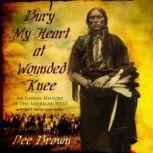
Later, as absurd as it may sound, some 20 US Cavalry soldiers were given the Medal of Honor – for killing innocent Lakota men, women and children. There was no peace on earth for the Lakota four days after Christmas. "It was the fourth day after Christmas in the Year of our Lord 1890, when the first torn and bleeding bodies were carried into the candlelit church, those who were conscious could see Christmas greenery hanging from the open rafters, across the chancel front above the pulpit was strung a crudely lettered banner: Peace on Earth, Good Will to Men," writes Dee Brown in Bury My Heart at Wounded Knee. Every time I think about Wounded Knee, I remember this: One poignant fact of the massacre has remained in my mind since first reading it.


Eventually, some of them were able to give an oral history of what happened. Some of those who survived were eventually taken to the Episcopal mission in Pine Ridge. The photograph of Big Foot’s frozen and contorted body is a symbol for all American Indians of what happened to our ancestors. The Lakota ancestors killed that day were left in brutal frigid wintry plains of the reservation before a burial party came to bury them in one mass grave. Some estimate the actual number closer to 300. One hundred and thirty-one winters ago, on December 29, 1890, some 150 Lakota men, women and children were massacred by the US 7th Cavalry Regiment near Wounded Knee Creek on the Pine Ridge Indian Reservation. It has been updated to reflect 131 years that have passed since the tragic day. Editor’s Note: This commentary was originally published by Native News Online in December 2013. It tells a story that should not be forgotten, and so must be retold from time to time.Opinion.

A unique and disturbing narrative told with force and clarity, Bury My Heart at Wounded Knee changed forever our vision of how the West was won, and lost. Using council records, autobiographies, and firsthand descriptions, Brown allows great chiefs and warriors of the Dakota, Ute, Sioux, Cheyenne, and other tribes to tell us in their own words of the series of battles, massacres, and broken treaties that finally left them and their people demoralized and decimated. A national bestseller in hardcover for more than a year after its initial publication, it has sold over four million copies in multiple editions and has been translated into seventeen languages. Bury My Heart at Wounded Knee is Dee Brown's classic, eloquent, meticulously documented account of the systematic destruction of the American Indian during the second half of the nineteenth century.


 0 kommentar(er)
0 kommentar(er)
